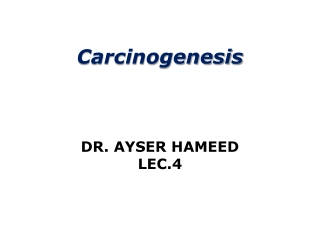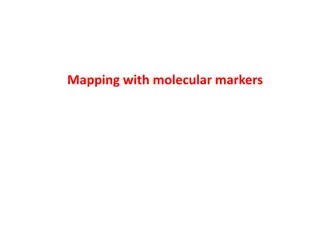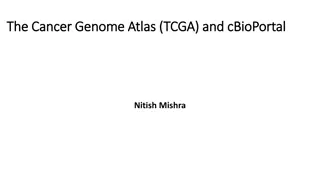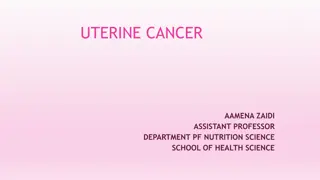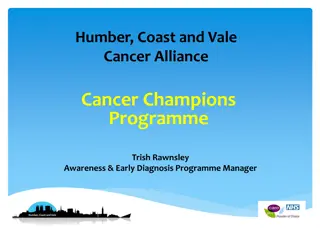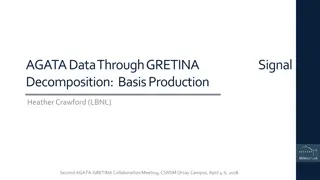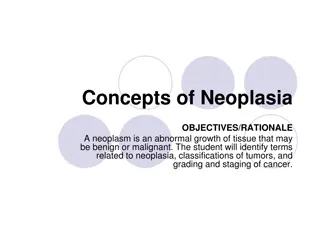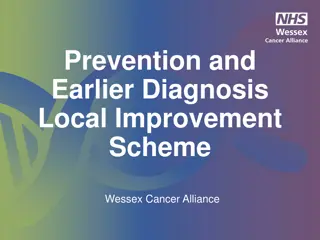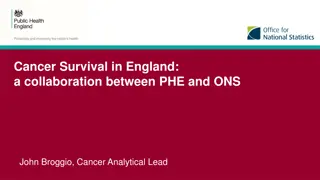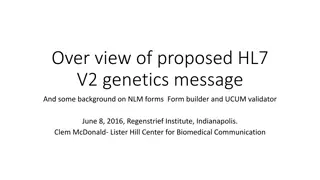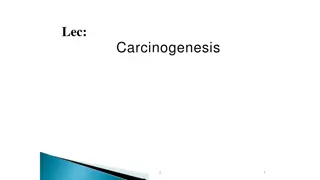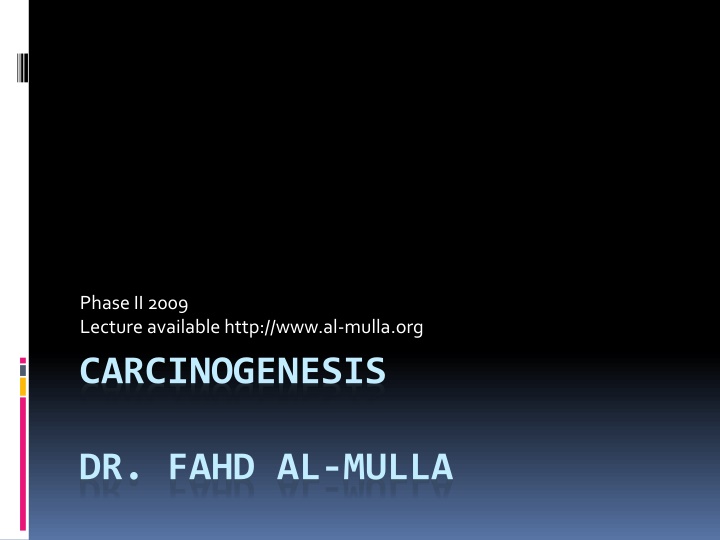
Overview of Carcinogenesis and Genetic Basis of Cancer
Carcinogenesis is the process of normal cells transforming into malignant cells due to genetic and environmental factors. This includes the introduction of genes and oncogenes, the role of tumor suppressor genes, and the Vogelstein model of tumor progression. Understanding the genetic basis of cancer is crucial in identifying risks and developing treatments.
Download Presentation

Please find below an Image/Link to download the presentation.
The content on the website is provided AS IS for your information and personal use only. It may not be sold, licensed, or shared on other websites without obtaining consent from the author. If you encounter any issues during the download, it is possible that the publisher has removed the file from their server.
You are allowed to download the files provided on this website for personal or commercial use, subject to the condition that they are used lawfully. All files are the property of their respective owners.
The content on the website is provided AS IS for your information and personal use only. It may not be sold, licensed, or shared on other websites without obtaining consent from the author.
E N D
Presentation Transcript
Phase II 2009 Lecture available http://www.al-mulla.org CARCINOGENESIS DR. FAHD AL-MULLA
Target knowledge What is carcinogenesis What is carcinogen Examples of carcinogens Chemicals Physical Zoonoses Initiators and promoters Environment and cancer Genetics and cancer Oncogenes/tumour suppressor genes Accumulation of genetic events Vogelstein s model Environmental and Genetic interaction
Carcinogenesis Process by which a normal cell is transformed into a malignant cell Neoplasia has genetic and environmental causes. It is important to note that both play parts in causing neoplasia. Genes influence the environmental factors
Genetic basis of cancer Introduction of genes (activated oncogenes) in normal Cells in culture make them transformed Transgenic mice/knock-in/out mice (mice with new onco-Genes introduced in cells at early embryological stages or removing genes from them) have a higher incidence of cancer Patients with well known inherited cancer syndromes in which inheritance of a single mutated gene have increased Risk of developing cancer.
Genetic basis of cancer Oncogenes Proto-oncogenes are normal cellular genes that regulate cell growth, division, and differentiation. Oncogenes are cancer-causing genes derived from proto-oncogenes by mutation (ras), retroviral transduction, gene amplification (myc and erbb2), or translocation (bcr-abl). Tumour suppressor genes Tumor suppressor genes are normal cell genes that "brake" cell division, activate apoptosis and repair DNA. Knudson two hit hypothesis.
Genetic basis of Cancer: Vogelstein Model Tumour progression implies the gradual transition of a localised, slow growing tumour to an invasive, metastatic cancer It was Vogelstein et al (1988)who put a firm molecular footing for the concept of multistep carcinogenesis As tumours progress to cancer they accumulate more genetic abnormalities. Deletions involving 17p (p53) were most frequent in carcinomas (75%) and were rarely found in early adenomas.
Loss of 5q Mutation and loss of Adenomatous Polyposis Coli (APC) gene. Genetic basis of cancer: Vogelstein s Model Normal epithelium Hyperproliferative epithelium DNA hypomethylation Mutation of ras genes Early adenoma Loss of 18q Loss of Deleted in Colorectal Carcinoma (DCC) gene Intermediate adenoma Loss of 17p Mutation and loss of TP53 gene Dysplastic adenoma Carcinoma Other alterations Metastases
Environmental basis of cancer
Carcinogens Agent Occupation Cancer Site Ionizing radiations radon certain underground miners bronchus X-rays, radium radiologists, radiographers skin It was Sir Percival Pott in 1775 who associated the increased incidence of scrotal skin cancer to chronic exposure to soot in chimney sweepers. Radium luminous dial painters bone Ultraviolet radiation farmers, sailors, etc. skin Polycyclic hydrocarbons in soot chimney sweepers,oil workers scrotum, skin, bronchus 2-Naphthylamine; 1- naph-thylamine rubber workers bladder Benzidine; 4- aminobiphenyl chemical workers bladder one Or a group of agents are to produce a neoplasm they have to damage more than one gene. Thus, the Neoplastic transformation is a progressive process involving multiple hits or genetic changes. Asbestos shipyard and insulation workers Mesothelioma lung Arsenic sheep dip manufacturers, gold miners skin and bronchus Benzene workers with glues, varnishes, etc. marrow (leukemia Vinyl chloride PVC manufacturers liver (angio- sarcoma) Aflatoxin B1 Food storage. Due to growth of Aspergillus flavus (fungi) Liver Benzo(a)pyrene Smokers Lung
How do Carcinogens work? Electrophiles (N,O,?S) Direct DNA damage or metabolites Pyrimidine Dimers (UV light) Radiation cosmic rays (DNA breaks) Dioxin in plastics Carcinogen can be initiator (incomplete) Carcinogen can be initiator and promoter (complete). E.g. virus
Carcinogens initiation/promotion Initiator: Initiation results from the exposure of cells to a certain doze of a carcinogen (initiator). An initiated cell is altered making it more likely to give rise to a tumour (if exposed to another agent; group 2 and 3 Promoters are compounds or processes (inflammation, viruses) that activates cell cycle Initiators and promoters work together Some agents are initiators and promoters do you know of any?
Carcinogens initiation/promotion
Carcinogens initiation/promotion Initiation Initiation Results from interaction of chemical with DNA to activate a proto oncogene oncogene or inactivate a tumor suppressor gene inactivate a tumor suppressor gene by formation of covalent adducts covalent adducts. Chemicals that can form adducts (direct acting) are usually electrophiles electrophiles. Many chemical carcinogens require activation (pro-carcinogens or indirect acting carcinogens) an example of a metabolic pathway is the p-450 cytochrome mono-oxygenase. Initiation alone does not result in tumours. Promotion Promotion Promoters are usually irritants or substances that produce cell activation and proliferation. Effects of promoters are reversible. Promoters cannot induce neoplasia: i) alone, ii) if applied before initiator, iii) if applied in too small an amount for effect, or iv) if too much time elapses between applications. activate a proto- - activation by metabolic pathways
Genetic and environmental interactions Why do carcinogens produce effect if we can repair DNA? Not all smokers get Lung cancer! Why? Amos et al Nature Genetics April 2008 conclude that variation in a region of 15q25.1 containing nicotinic acetylcholine receptors genes contributes to lung cancer risk.
Genetic and environmental Interactions
Thank you Any Questions?

